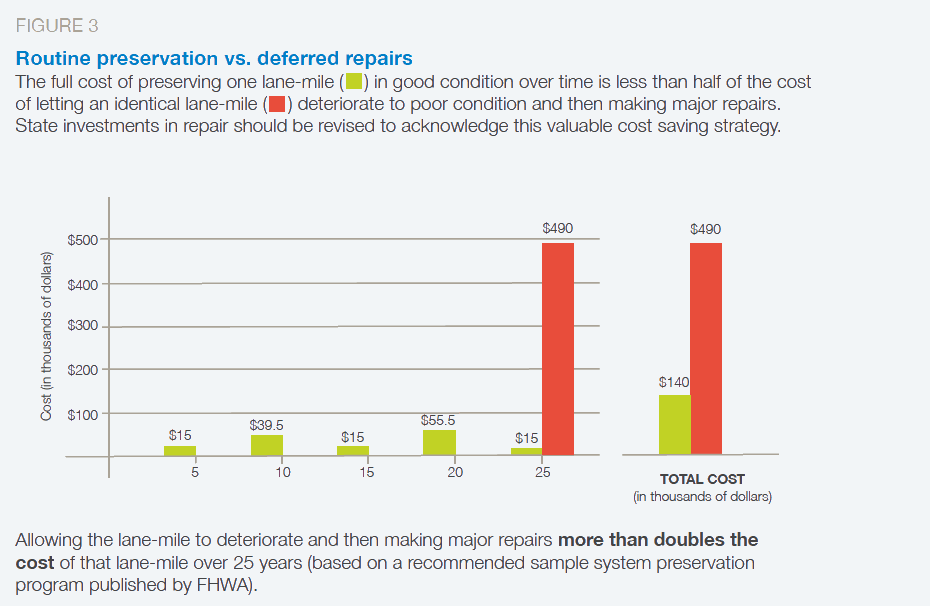SMART GROWTH AMERICA & TAXPAYERS FOR COMMON SENSE
Decades of disproportionate spending by states on road expansion at the expense of regular repair have left many state roads in poor condition. Federal Highway Administration data indicate that half of all major state roads were in “fair” or “poor” condition in 2008, and in 2009 the American Society of Civil Engineers gave the nation’s roads a “D-,” down from a “D” in 2005.
In spite of this enormous repair backlog, the vast majority of states continue to inadequately fund road repair projects. By underfunding repair and allowing roads to fall out of good condition, state leaders are choosing the most expensive type of repair possible, as rehabilitating a road that has completely deteriorated is substantially more expensive than keeping that road in good condition in the first place.
Adding further urgency to these budget concerns is that with every dollar spent on new construction, states add to a road system they are already failing to adequately maintain. As a result, states face a large and growing financial burden.
A smarter investment: road repair and preservation
Investing in repair and preservation does more than make headway on an inevitable problem; it actively reduces the scale of future costs. According to the American Association of State Highway and Transportation Officials, every $1 spent to keep a road in good condition avoids $6-14 needed later to rebuild the same road once it has deteriorated significantly. Prioritizing repair and preservation makes good fiscal sense and brings with it a host of additional benefits. This report examines road conditions and spending priorities in all 50 states and the District of Columbia and recommends changes at the state and federal level that would benefit taxpayers while creating a better transportation system.
Federal taxpayers have a significant interest in seeing that states keep the nation’s roads in a state of good repair. Though much of the funding for repair and preservation comes from state and local budgets, billions of federal dollars are also spent each year on these roads. Federal funds built a large portion of these major state roads, and allowing states to under- invest in repair and preservation greatly reduces the value of these federal investments. In addition, roads in poor condition can negatively impact interstate trade and travel, the effects of which can be felt across large regions and across state lines.
State leaders make a number of decisions about transportation spending that shape their long-term financial trajectories. All 50 states and the District of Columbia can benefit from aligning transportation policies with capital spending decisions to make sure roads are kept in good repair. Doing so can prevent neglected preservation from undermining the value of their own infrastructure investments.
Download full version (PDF): Repair Priorities
View interactive map (SmartGrowthAmerica.org)
About Smart Growth America
www.smarthgrowthamerica.org
“Smart Growth America is the only national organization dedicated to researching, advocating for and leading coalitions to bring smart growth practices to more communities worldwide. The coalition includes many of the best-known national organizations advocating on behalf of historic preservation, the environment, farmland and open space preservation, neighborhood revitalization and more.”
About Taxpayers for Common Sense
www.Taxpayer.net
“Taxpayers for Common Sense is a 501(c)(3) non-partisan budget watchdog serving as an independent voice for American taxpayers. Our mission is to achieve a government that spends taxpayer dollars responsibly and operates within its means. We work with individuals, policymakers, and the media to increase transparency, expose and eliminate wasteful and corrupt subsidies, earmarks, and corporate welfare, and hold decision makers accountable.”
Tags: Reconnecting America, Smart Growth America, Taxpayers for Common Sense







 RSS Feed
RSS Feed